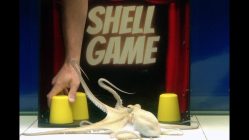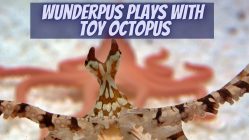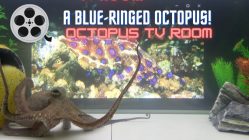There’s more than one way to eat a crab!
If any of you have ever had to eat on the run, you know that there is more than one way to eat than sitting comfortably at the dining room table. Sometimes you have to eat standing up, other times while walking, driving, or working.
The same holds true for octopuses. Sure, an octopus prefers to catch his meal and take it back to a secluded spot where he can eat in privacy. However, sometimes the opportunity for a meal comes up under some very special circumstances.
The Crab in the Cage Experiment
In this video, you will see how one of our eight-armed friends in the Octolab experiment tank reacts when he sees one of his favorite snacks in a cage in the tank with him.
The cage is made out of a strong wire frame and the slots are extremely narrow. The door is locked and there is no way to get in or out.
The crab, being a crab, is unaware of what is lurking around him outside of the cage.
The octopus in the meantime is eyeing the crab much as you would eye a luscious apple pie behind the counter at your favorite bakery.
Octopuses Are Crafty Hunters and Killers
In the wild, octopuses use many tactics to capture prey. Sometimes they rely on their ability to camouflage themselves perfectly with the background. They just lay in wait for their dinner to come to them grabbing it with their arms when it gets close enough. Other times, they actively engage in a chase of their prey.
There are also those moments when the octopus’ uses its ability to reach and squeeze into the tightest of places. Remember, an octopus has no bones. This allows him to access nooks and crannies which seem too small for him.
If He Can Grab It, He Can Eat It
Our octopus employs a very effective technique in order to snack on this caged crab. He slides his arms through the cage bars. Having nowhere to run, the crab is pulled toward the bars.
You see the crab struggle but only for two or three seconds. Almost immediately the crab’s movements stop — as if paralyzed.
Well, that is exactly what happened. When our octopus grabbed the crab and pulled it toward the bars he also managed to bring his beak close enough to pierce the crab and inject him with toxins and digestive enzymes. Trust us, that will really put a damper on your day as the crab would surely attest if it were still with us.
With the crab immobilized the octopus goes about the business of trying to pull it out. Octopuses are strong, but not quite strong enough to pull the cage apart like a “super mollusk.”
Instead, the octopus consumes the crab — at least the tender meat and insides that his digestive juices had already started softening — by sucking it through its beak. No need to pull the crab out. Sort of like slurping on a milkshake through a straw.
When done, all that’s left is the empty crab shell. How’s that for an innovative eating style?











